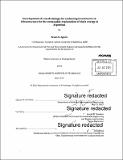| dc.contributor.advisor | Joseph M. Sussman. | en_US |
| dc.contributor.author | Agosta, Bruno R | en_US |
| dc.contributor.other | Massachusetts Institute of Technology. Department of Civil and Environmental Engineering. | en_US |
| dc.coverage.spatial | s-ag--- | en_US |
| dc.date.accessioned | 2015-10-30T18:58:50Z | |
| dc.date.available | 2015-10-30T18:58:50Z | |
| dc.date.copyright | 2015 | en_US |
| dc.date.issued | 2015 | en_US |
| dc.identifier.uri | http://hdl.handle.net/1721.1/99594 | |
| dc.description | Thesis: S.M., Massachusetts Institute of Technology, Department of Civil and Environmental Engineering, 2015. | en_US |
| dc.description | Cataloged from PDF version of thesis. | en_US |
| dc.description | Includes bibliographical references (pages 153-157). | en_US |
| dc.description.abstract | In 2011, a new word entered into the popular vocabulary of Argentina: Vaca Muerta (VM, literally: Dead Cow); almost like a discovery, it was announced that Argentina had large hydrocarbon resources that were trapped in underground shale and tight rocks. In reality, these resources were known by geologists from the beginning of the oil industry, but only became economically extractable in the 2000s, with the use of two old technologies developed in the US and already used on conventional fields: hydraulic fracturing and horizontal drilling. With this "discovery," the Argentine energy perspective changed radically: a sector that was declining became dynamic again and became a target for investment for a project that for many Argentines was still just a name. By 2014, around three billion dollars has been invested in VM almost exclusively by the oil & gas sector, led by the national oil company (YPF), but there were very few analyses on how VM would affect other sectors, like the logistics and transportation system. By the intrinsic technical characteristics of these two essential technologies, the amount of inputs required in the wellheads is extremely high (especially in comparison with conventional exploitations), producing a strong demand for transportation and logistics services. This high volume of transportation services requires infrastructure capacity, meaning large long-term investments. Following this, a key question arises: who should pay for new capacity of public infrastructure that will be used by a few actors in a private business (oil and gas) that is profitable? Should it be the public sector through the use of tax-revenues or should it be the private sector that must pay with its own savings generated by using more efficient transport modes? Seeking to answer these questions, this thesis developed and implemented a Simultaneous Economic-Financial Analysis Model (SEFAM) to evaluate the private and public incentives that will finally determine investment alternatives to achieve socially optimal solutions. The CLIOS Process, for studying complex sociotechnical systems, is used to study the relationships between the shale oil production system and the logistic and transportation system, with the institutional actors that govern them. The East-West VM supply corridor was selected as the research case of this thesis, in order to implement SEFAM and draw some general conclusions. This research describes this interaction between shale energy production and its logistic and transportation requirements, along with the proposition of certain questions that advance a better understanding of the problem. SEFAM is then seen as an integrative tool that allows the decision-maker to have useful and relevant information for a prospective negotiation process between the public and private sectors, looking to ensure the implementation of the socially optimal alternative. | en_US |
| dc.description.statementofresponsibility | by Bruno R. Agosta. | en_US |
| dc.format.extent | 157 pages | en_US |
| dc.language.iso | eng | en_US |
| dc.publisher | Massachusetts Institute of Technology | en_US |
| dc.rights | M.I.T. theses are protected by copyright. They may be viewed from this source for any purpose, but reproduction or distribution in any format is prohibited without written permission. See provided URL for inquiries about permission. | en_US |
| dc.rights.uri | http://dspace.mit.edu/handle/1721.1/7582 | en_US |
| dc.subject | Civil and Environmental Engineering. | en_US |
| dc.title | Development of a methodology for evaluating investments in infrastructure for the sustainable exploitation of shale energy in Argentina | en_US |
| dc.type | Thesis | en_US |
| dc.description.degree | S.M. | en_US |
| dc.contributor.department | Massachusetts Institute of Technology. Department of Civil and Environmental Engineering | |
| dc.identifier.oclc | 925478394 | en_US |
